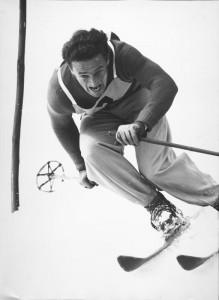
Giant slalom was invented in Italy in 1935 — the result of an accident of weather, according to a recent article in the magazineSciare. It happened when a downhill race, scheduled to take place on January 19, 1935, in Mottarone, above Lake Maggiore in Piedmont, had to be modified because of lack of snow.
In place of the classic, open downhill of the time, the FISI (Italian Ski Federation) commissioner Gianni Albertini decided
Helmuth Lantschner at Kitzbuehel, 1939
to prepare a new course with gates, forcing the racers to follow a specific path down the mountain. The vertical drop was quite small, 300 meters (a thousand feet), so he decided that the race should be in two runs. The winner, Austria’s Helmuth Lantschner took two minutes thirty-one and one-fifth seconds. Giacinto Sertorelli, the Italian ace, was third, six seconds behind.
FISI was so satisfied with the new formula that they officially introduced the giant slalom race in the Italian championships at Cortina, February 12, 1935. A course was prepared on the Olympia delle Tofane, 900 meters vertical drop, course setter, once again, Gianni Albertini. Twenty-six male competitors started. The race was won by Giacinto Sertorelli, in six-and-a-half minutes. Six women competed. The winner was Paula Wiesinger, in eight minutes 19.8 seconds.
A recent article in Skiing Heritage gave attention to the American contribution to the development of the GS — a 1937 race at Mt. Washington. Yet it was the Italians who sponsored an annual—and international—race. In 1936 there was one on a shortened course on the Marmolada, won by Eberhardt Kneissl of Austria. Full 50-gate slaloms were won in 1937 by Josef Gstrein (AUT), in 1939 by Vittorio Chierroni (ITA). Women’s races took place in 1935 with Gabriella Dreher (ITA) winning, Elvira Osirnig (SUI) in 1936.
Aspen in 1950 marked the first FIS World Alpine Ski Championships to include giant slalom. The gold medal was won by Italy’s Zeno Colò, who also won the downhill and took a silver in slalom. From the FIS GS at Aspenonward the GS was a one-run race until the World Championships at Portillo,Chile, in August 1966 when the men raced two runs, the women still one run. Four years later at Val Gardena, Italy, women began to race two runs in world championship GS.
Matteo Pacor, who operates the superb racing results website www.ski-db.com, recalls his first experience of watching a two-run giant slalom during the Innsbruck Olympics in 1976, held over two days. “I was ten years old and a huge fan of Ingemar Stenmark. He skied badly in the first run. I didn’t sleep well.”
(Matteo Pacor, John Allen and John Fry contributed to this article. Photo of Helmuth Lantschner shot in Kitzbuehel, 1939)
